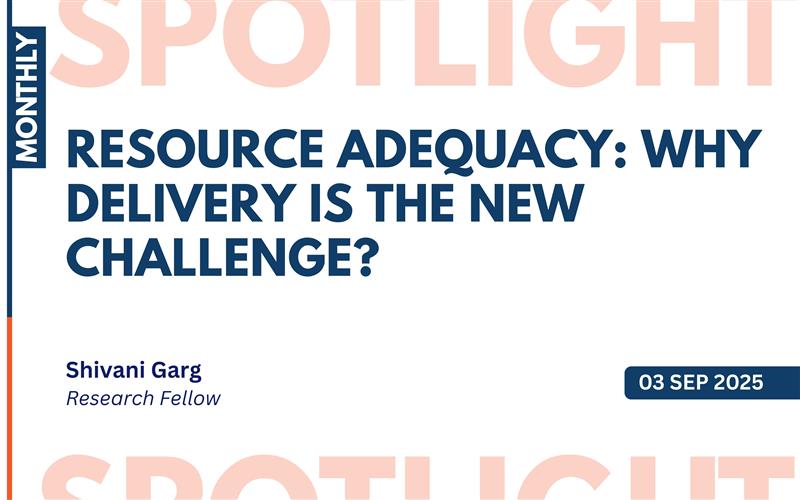MONTHLY SPOTLIGHT
Resource Adequacy: Why Delivery Is the New Challenge?

For decades, system operators defined Resource Adequacy (RA) as the generation capacity needed to guarantee meeting the peak demand plus a reserve margin. This capacity centric approach has influenced capacity procurement, utility planning, and regulatory assessment. However, the rapid expansion of variable renewable energy (RE), the decentralised generators, and the rising frequency of climate-induced disruptions demand a fundamental rethinking of what constitutes an “adequate” power system.
Fundamentally, RA is about reliability-the assurance that power reaches the consumers when and where needed. But, conventional generation-centric RA models are inadequate when generation depends on weather, and the path from source to load becomes more complex and/or vulnerable. Today, ensuring RA necessitates a comprehensive, network-centric approach – encompassing generation, transmission, distribution infrastructure and system-wide resilience.
Why the Old Paradigm Struggles?
Traditional RA planning relies on metrics like loss of load expectation (LOLE) and planning reserve margin (PRM) to assess the generation adequacy against the projected peak demand. These deterministic measures worked when fossil fuel generators provided relatively consistent and predictable output. However, these measures can mislead in systems with high integration of wind and solar power.
Variable RE sources generate electricity inconsistently based on weather conditions, which are difficult to forecast accurately. Simply counting installed RE megawatts provides little insight into whether it enhances reliability during critical periods. Effective load carrying capacity (ELCC), a probabilistic metric measuring a resource’s contribution is one technique which is used to assess the firm capacity offered by variable generators, however, even this method falls short if network constraints or system resilience are disregarded.
Importance of Network Adequacy
As the share of renewables increases robust, flexible, and well-coordinated transmission becomes exponentially important. Many renewable resources are located far from urban load centers, such as solar in deserts, wind on remote plains necessitating long-distance transmission. Without adequate transmission infrastructure, the RE generation may need to be curtailed, making them less effective during times of high demand.
In Rajasthan, with over 23GW of solar capacity, transmission overloads have caused up to 48% curtailment during peak hours – resulting in losses of more than ₹2.26 billion since April 2025. Despite India targeting ₹91.2 billion in interstate transmission capacity additions by 2032, the pace lags renewable deployment.[1]
Distribution networks, too, face new pressures from rooftop solar, electric vehicles (EV), and other distributed energy resources (DER). This is transforming the local grids into bidirectional systems. Distribution adequacy, the local grid’s ability to handle variable, bidirectional flows, becomes essential for consumer-level reliability.
Bengaluru and tier-2 cities in Karnataka frequently face load shedding – despite the state claiming to be ‘power-surplus’. Similarly, in Rajasthan, high solar output in the middle of the day has had to be curtailed because transmission lines to demand centres such as Delhi and Haryana reached their capacity limits.[2] [3]
A generation surplus means little if the infrastructure cannot deliver the power where needed. Grid congestion, transformer overloads, voltage instability, and localised outages plague the power systems, especially as loads evolve and decentralise. Network planning can benefit from our energy surplus ONLY IF it proactively accounts for these requirements.
Resilience: The Third Pillar
Even with adequate generation and network capacity, power systems remain vulnerable to disruptions. Increased frequency and severity of extreme weather events like heat wave, floods, wildfires, hurricanes and others affecting both supply and grid infrastructure simultaneously. For instance, in the year 2024, India has observed around 34% of the rise in power usage from March through early April due to extreme heatwaves. [4] [5]
Resilience – the system’s ability to withstand and recover from any severe disruptions, needs to be a critical component of RA. This requires infrastructure hardening, operational flexibility, black-start capabilities, and sustainable integration of distributed resources like batteries and microgrids for emergencies.
Toward an Integrated RA Framework
The evolving landscape calls for an integrated RA framework that encompasses:
1. Generation Adequacy: Assessing fuel availability, outage risks, and capacity value of variable resources – in addition to the installed capacity.
2. Transmission & Distribution Adequacy: Ensuring the physical delivery of power through robust, flexible, and appropriately sized networks.
3. Demand-Side Contributions: Including demand response, energy efficiency, and flexible loads as active resources in adequacy planning.
4. Resilience Metrics: Incorporating climate risk, recovery time, and system adaptability into adequacy assessments.
Advanced modeling tools, real-time data, and coordination among utilities, regulators and market operators will enable such a framework. Probabilistic assessment techniques, rather than deterministic rules, become essential for managing modern power system uncertainties.
Conclusion: A Paradigm Shift in Progress
Adequacy is no longer about the Megawatts installed – it is about the megawatts delivered and maintained consistently under a wide range of circumstances. As the energy transition accelerates, planners, policy makers, and system operators need to adopt a more holistic approach to estimate adequacy for an increasingly decentralized, climate-sensitive, and interconnected power system.
Rethinking RA means moving from a static, capacity-based mindset to a dynamic, delivery-and-resilience-oriented framework. Only then can we build power systems that are truly reliable, secure, and fit for the future.
[1] “Policy Study on Energy Transition Roadmap 2030”, report of Council on Energy, Environment and Water. https://www.ceew.in/publications/policy-study-energy-transition-roadmap-2030.
[2] “Status of power generation and power supply position in the country”, https://www.pib.gov.in/PressReleasePage.aspx?PRID=1988262
[3] TOI article on “In energy surplus Karnataka, why is Bangaluru facing power cuts” https://timesofindia.indiatimes.com/city/bengaluru/in-power-surplus-state-why-is-bengaluru-facing-frequent-power-outages/articleshow/119438920.cms
[4] “How Extreme Heat is Impacting India”, report of Council on Energy, Environment and Water. https://www.ceew.in/sites/default/files/mapping-climate-risks-and-impacts-of-extreme-heatwave-disaster-in-indian-districts.pdf
